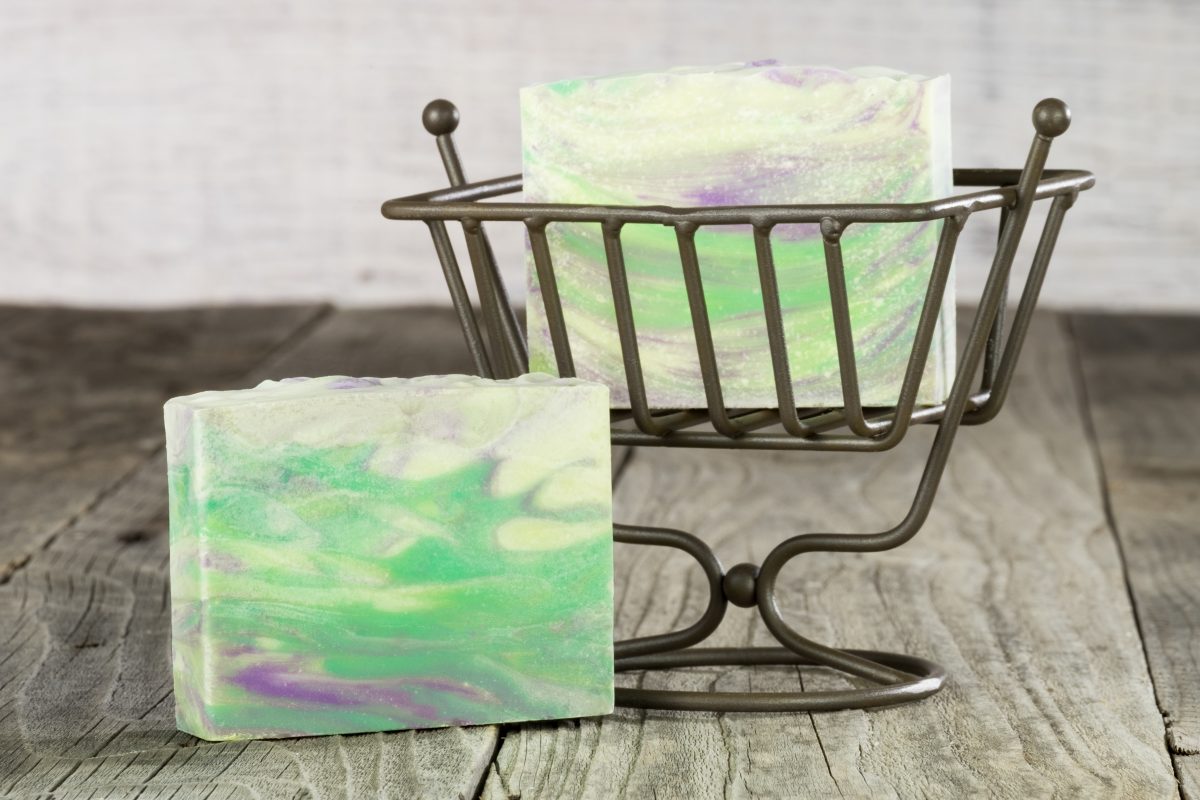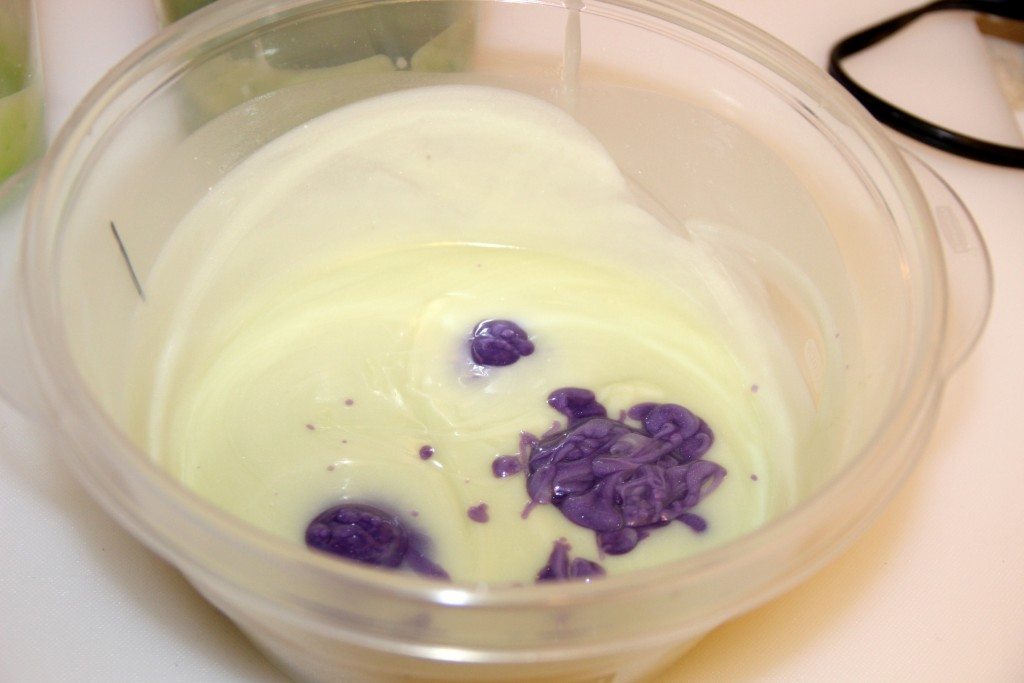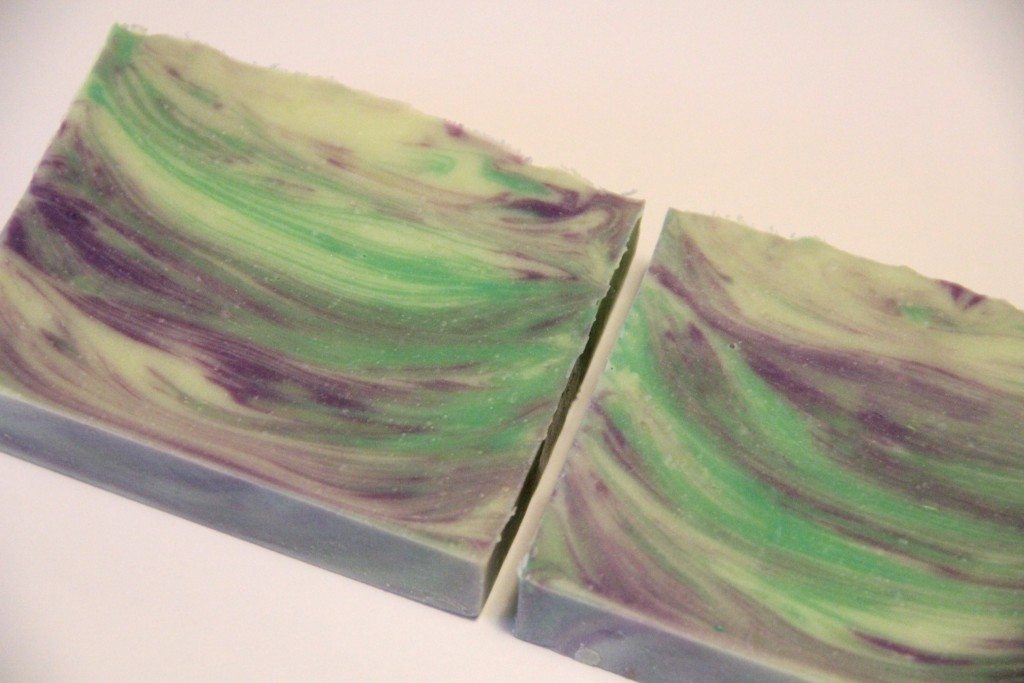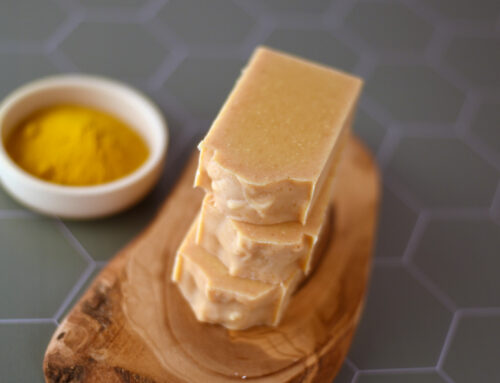This soap uses Aloe Vera Liquid (Bramble Berry) in place of the water. Aloe Vera adds moisturizing properties to soap and makes for a dense and lotion-like lather. You can harvest your own Aloe Vera or you can use the liquid from Bramble Berry.
Photo by Busy Bee Creative – Product Photography
Lavender Mint Aloe Vera Soap Recipe
1 lb Palm-free Recipe (Fits in short silicone loaf mold from WSP. Perfect for test batches.)
Coconut Oil – 136 grams (30%)
Olive Oil – 160 grams (35%)
Avocado Oil – 68 grams (15%)
Castor Oil – 45 grams (10%)
Apricot Kernel Oil – 45 grams (10%)
Sodium Hydroxide – 63 grams
Aloe Vera Liquid – 126 grams
Lavender Essential Oil – 15 grams
Peppermint Essential Oil – 15 grams
Kelly Green Mica (Bramble Berry) – 1/4 teaspoon
Kermit Green Mica (Bramble Berry) – 1/4 teaspoon + 1/8 teaspoon
Lavender Mica (Bramble Berry) – 1/4 teaspoon
White Mica – 1/2 teaspoon
2 lb Palm-free Recipe (Fits high in 8″ silicone loaf mold or just under full in 10″ silicone loaf mold.)
Coconut Oil – 272 grams (30%)
Olive Oil – 320 grams (35%)
Avocado Oil – 136 grams (15%)
Castor Oil – 90 grams (10%)
Apricot Kernel Oil – 90 grams (10%)
Sodium Hydroxide – 126 grams
Aloe Vera Liquid – 252 grams
Lavender Essential Oil – 30 grams
Peppermint Essential Oil – 30 grams
Kelly Green Mica (Bramble Berry) – 1/2 teaspoon
Kermit Green Mica (Bramble Berry) – 1/2 teaspoon + 1/4 teaspoon
Lavender Mica (Bramble Berry) – 1/2 teaspoon
White Mica – 1 teaspoon
Safety Warning: This recipe is for soapmakers who have a basic knowledge of the soapmaking process and know the correct safety procedures to use when handling lye. If you are new to soapmaking, visit our free soap making guide or check out our Basic Soapmaking eBook. Be sure to wear safety goggles and gloves while soaping.
Step 1 – Create your lye solution. Weigh out the Aloe Vera Liquid and sodium hydroxide into separate containers.
Step 2 – In a well-ventilated area, sprinkle the sodium hydroxide into your Aloe Vera Liquid while stirring slowly. Stir until dissolved and set aside to cool. Your solution might turn yellow or orange. This is normal when making a lye solution with Aloe Vera Liquid or fresh Aloe Vera.
Step 3 – Weigh out the coconut oil and melt, just until melted.
Step 4 – Weigh the liquid oils and add to the melted oils.
Step 5 – Add essential oils to the oil mixture. Mix.
Step 6 – Pour the lye solution into oils and bring to light trace.
Step 7 – Divide the mixture evenly into four containers. For three containers, color each with kelly green, kermit green and lavender mica. In the base container, color using the second amount of kermit green and white mica to create a light green base.
Step 8 – To create an in-the-pot swirl, simply pour each base color back into your main pot as shown. I usually aim for pouring the soap into three areas of the base, rotating colors. There really isn’t a wrong or right way to do it. If your soap gets thick, no worries. Mine got a bit thick.
Step 9 – Using a spatula or spoon, turn the soap once. This helps to swirl the soap.
Step 10 – Pour the soap into your mold. This is where the magic happens. As you pour, the soap swirls even more.
Let sit for 24 hours to saponify and harden. Remove after 24 hours in the mold. Cut and let cure for 4 weeks.
Happy Soaping!
Amanda Gail



























I just made this recipe and used Aloe Vera Gel that looks like a liquid from Walmart. It had the same ingredients and preservatives on the label as the BBerry Aloe, so I thought it would work. It wouldn’t trace after 20 minutes. I put it in the mold anyway and after 1/2 hour it just separated out with the Aloe floating on the top. I threw the whole expensive batch out. Ouch! I also thought it was strange to put the Essential Oils into the oil before adding the lye. It doesn’t make sense to destroy the delicate properties of the oils by zapping it with a harsh chemical as lye.
In all my years of soaping, I’ve never had an issue with “zapping” essential oils with lye in cold process – seeing that saponification takes up to 24 hours, it really doesn’t matter WHEN the essential oils are being added to the soap. They’ll come through just fine.
Never heard of any problems with using essential oils in soap. And definitely never heard anything about “zapping” the properties of EOs in soap. I’m making the same batch tomorrow I always do with Lavender & Peppermint EOs. Margo, there is a lot of good scientific info out there about EOs in soap. Google, Kevin Dunn or Robert Tisserand.
Hi there, what a gorgeous recipe! Is it OK to replace apricot kernel oil with almond oil? Cheers! Luke
Hey Amanda.. i plan to use fresh aloe vwra gel instead of the juice. Have a question for you.
Should I turn the gel into a puree by adding D. water and use this liquid instead of water for the lye solution? or use part amount of water in the gel and use the remaining part of the total needed into making the lye solution.
Beautiful! Thanks so much for sharing 🙂
Beautiful colors
Thank you!
While I think BrambleBerry is a wonderful source for many materials, I just wanted to point out that you can buy Aloe liquid at Walmart in the pharmacy area, and I expect it’s cheaper that way (plus no shipping charge).
That’s a great tip for those that want to go out and get some today! Thank you, Cindy! 🙂
OMG…..I was thinking the same thing….Walmart,Lol. Good plug for BB though;)
Love this! I’ve never done a swirl before and a have a new 2 lb mold from WSP. This looks so easy, maybe even I can do it. Thanks!
I love the EO blend. Question: Can I use aloe vera gel in place of aloe vera liquid?
Thanks,
Nancy
I believe you can! I haven’t tried it though… I know that the gel does have added things in it, so check the ingredients.
I love lavender mint and I sale more of this then any of my other wholesales. It help you relax and pick you up all at the same time..it’s a great all around scent